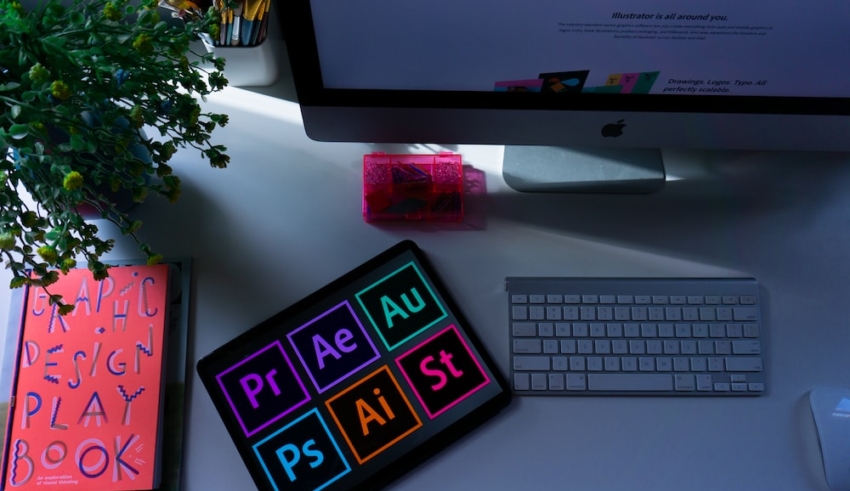
Graphic design plays a crucial role in today’s world, where visual communication is more powerful than ever before. In a constantly evolving digital landscape, businesses and individuals rely on effective graphic design to convey their messages and capture attention. Whether it’s a website, social media post, or advertising campaign, the visuals are what often first catch our eye and make us stop scrolling. Graphic designers have the power to create compelling designs that communicate meaning and evoke emotions.
Moreover, graphic design has become an essential tool for building brand identity and recognition. Logos, color palettes, typography – these elements are meticulously crafted by graphic designers to encapsulate an organization’s values and personality. Consistency is key to establishing a strong brand presence across various platforms and mediums. A well-designed brand can leave a lasting impression on consumers’ minds and make them more likely to engage with the product or service.
Furthermore, as technology continues to advance at breakneck speed, graphic design is also intersecting with other fields, such as user experience (UX) design. UX designers recognize that seamless navigation combined with visually appealing interfaces is vital for creating positive user interactions with websites or applications. By integrating aesthetics into functional designs that prioritize usability and accessibility, graphic designers contribute to enhancing the overall user experience.
In conclusion, the importance of graphic design in today’s world cannot be underestimated. It has the power to captivate audiences through visually impactful communication while also helping businesses establish their unique identities.
Table of Contents
Essential skills for graphic designers
One essential skill that sets apart exceptional graphic designers from the rest is the ability to think critically and problem-solve. Designers must be able to analyze a brief or client’s requirements, identify the core message, and translate it into effective visual communication. They need to approach each project with a curious and open mindset, constantly asking questions and pushing themselves to explore new ideas.
Another crucial skill for graphic designers is mastery of design software and tools. In today’s digital age, proficiency in programs like Adobe Photoshop, Illustrator, and InDesign is practically mandatory. However, great designers go beyond just knowing how to use these tools; they understand the principles of design – color theory, typography, layout – and can manipulate the software to bring their creative visions to life. Additionally, staying up-to-date with industry trends and emerging technologies ensures that designers can remain competitive in an ever-evolving field.
Finally, effective communication skills are vital for graphic designers as they often collaborate with clients or work as part of a team. The ability to clearly articulate ideas or concepts ensures that everyone involved in a project is on the same page. This includes not only verbal communication but also visual presentation skills, such as creating well-organized mood boards or mock-ups. Strong communication allows designers to effectively share their vision while also understanding feedback and making necessary adjustments for client satisfaction.
Understanding color theory and composition
Understanding color theory and composition is key to creating visually appealing designs. Color is a powerful tool that can evoke emotions, convey messages, and enhance the overall impact of a design. When it comes to color theory, there are certain principles that every graphic designer should be familiar with. One of these principles is the color wheel, which helps designers understand how colors relate to each other and create harmonious combinations.
In addition to color theory, composition plays a crucial role in graphic design. Composition refers to the arrangement of elements within a design and how they interact with each other. It involves balancing visual weight, organizing space, and creating a sense of harmony and unity. By understanding composition techniques such as the rule of thirds or the golden ratio, designers can create layouts that are visually pleasing and effectively communicate their message.
Mastering color theory and composition allows graphic designers to create designs that stand out from the crowd. A deep understanding of how colors work together can help them choose palettes that enhance readability and draw attention to important elements. Similarly, knowledge about composition enables them to arrange elements in a visually engaging manner while maintaining balance and flow.
Mastering typography and font selection
When it comes to graphic design, typography is one of the most crucial elements to master. The right font can make or break a design, conveying mood, tone, and meaning with its subtle intricacies. As a designer, it’s essential to understand how different fonts work together and complement each other in order to create visually appealing and cohesive designs.
Font selection requires careful consideration and should align with the overall message or brand identity you’re trying to convey. It’s important to choose fonts that not only look aesthetically pleasing but also reflect the personality of your project. Pairing serif fonts with sans-serif fonts can create a pleasing contrast and add visual interest. Additionally, considering factors such as readability, legibility at different sizes, and cultural associations of certain typefaces can help you choose the perfect font for your design.
Another aspect of mastering typography is understanding the art of kerning and letter spacing. These seemingly small details play a significant role in ensuring readability and overall harmony in your design. Properly kerned text creates balanced spacing between individual letters while still maintaining a natural flow. Experimenting with different levels of letter spacing can also help you achieve various effects – from elegant and spacious layouts to tight-knit compositions that demand attention.
In conclusion, mastering typography involves more than simply selecting beautiful fonts; it requires an understanding of how different typefaces work together harmoniously.
Utilizing software and design tools effectively
Utilizing software and design tools effectively is essential for graphic designers to stay ahead in a fast-paced industry. While there are countless options available, it’s important to identify the tools that best fit your specific needs and workflow. Experiment with various programs and find one that not only offers a comprehensive range of features but also aligns with your personal style and preferences.
Investing time in learning how to optimize these tools will pay off tremendously in the long run. Take advantage of online tutorials, webinars, and forums where professionals share tips and tricks for getting the most out of each software program. Additionally, regularly updating your skills by attending workshops or online courses can help you stay up-to-date on the latest advancements in design software.
Apart from mastering specific software programs, it’s crucial to understand the fundamental principles of design. Regardless of which tool you use, knowing how to effectively apply color theory, typography techniques, and layout principles will elevate your designs from good to great. The key lies not simply in using the latest trends or gimmicks offered by these tools but rather harnessing them creatively with an understanding of timeless design principles.
By continually exploring new software programs while building a strong foundation in core design concepts, graphic designers can harness the power of technology effectively. This combination allows for limitless creativity while ensuring designs are captivating and effective across various platforms. So embrace the world of design software confidently – there’s no limit to what you can achieve!
Staying updated with current design trends
As a graphic designer, staying updated with current design trends is crucial for maintaining relevance and creating visually appealing work. With technology constantly evolving and new styles emerging, it’s essential to keep a finger on the pulse of the design world. One way to do this is by regularly exploring design blogs and websites that showcase the latest trends in typography, color palettes, layouts, and graphic elements. By immersing yourself in these resources, you can gain inspiration and insights that will inform your own creative process.
Another effective strategy for staying updated with design trends is by attending industry conferences and events. These networking opportunities not only allow you to learn from other professionals but also expose you to cutting-edge design techniques and technologies. Furthermore, connecting with other designers at these events can open doors for collaboration opportunities in the future.
While it’s important to be aware of current trends, as a graphic designer, it’s equally important to develop a distinctive style that sets you apart from others in your field. By understanding the principles underlying various design trends—such as balance, contrast, and unity—and incorporating them into your work in unique ways, you can create designs that are not only aesthetic but also authentically yours. Ultimately, being knowledgeable about current trends while also striving for originality will ensure that your work stands out among competitors while still resonating with modern audiences.
Conclusion: Continuous learning is key to success
In conclusion, continuous learning is more than just a nice-to-have attribute for graphic designers – it’s an absolute necessity. The design field is constantly evolving, and what was cutting-edge yesterday may be outdated today. By staying updated with the latest trends, technologies, and techniques, designers can ensure that their work remains relevant and impactful.
Furthermore, the ability to adapt and learn new skills is key to staying competitive in the industry. With advancements in technology, new software and tools are being introduced regularly. Designers who embrace these changes and invest time in learning how to use them will have a distinct advantage over those who stick to old methods.
Moreover, continuous learning fosters creativity by exposing designers to different perspectives and ideas. It encourages them to explore new approaches and push boundaries in their work. This mindset of curiosity enables designers to think outside the box, experiment with new techniques, and ultimately create innovative designs that captivate audiences.
In essence, success as a graphic designer relies on an individual’s willingness to never stop learning. With such a fast-paced industry that demands constant growth and adaptation, embracing continuous learning becomes paramount. By doing so, designers can not only stay ahead of the curve but also continuously evolve as professionals in pursuit of creating exceptional design work that leaves a lasting impact on vi.














